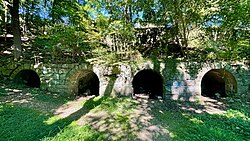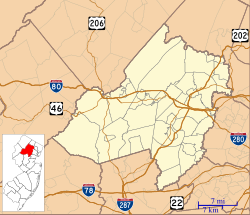Boonton Iron Works
 From Wikipedia - Reading time: 8 min
From Wikipedia - Reading time: 8 min
Boonton Ironworks Historic District | |
 Remains of stone foundation with arches at the Boonton Ironworks | |
| Location | Plane Street, Grace Lord Park Boonton, New Jersey |
|---|---|
| Coordinates | 40°54′18″N 74°24′48″W / 40.90500°N 74.41333°W |
| Area | 53 acres (21 ha) |
| NRHP reference No. | 100009115[1][2] |
| NJRHP No. | 5723[3] |
| Significant dates | |
| Added to NRHP | July 14, 2023 |
| Designated NJRHP | March 21, 2023 |


The Boonton Iron Works were founded about 1770 by Samuel Ogden who, with others in his family, purchased a 6-acre (24,000 m2) tract along the Rockaway River, near present-day Boonton, New Jersey. Here rolling and slitting mills were erected that engaged in the manufacture of nail rods and bar iron. With the construction of the Morris Canal in 1830, the New Jersey Iron Company was organized. This company built a new plant costing $283,000 (equivalent to $8.1 million in 2023) and imported skilled mechanics from England. Under Fuller & Lord (1852–1876) the enterprise become an integrated industry with ore and timber reserves, canal boats, furnaces, mills and auxiliary plants. After 1881, the business slowly declined. The plant closed in 1911.
Historic district
[edit]The property was listed as the Boonton Ironworks Historic District on the National Register of Historic Places on July 14, 2023, for its significance in engineering, industry, and transportation. The 53-acre (21 ha) historic district located in Grace Lord Park in the town of Boonton includes 13 contributing sites and 2 contributing structures. It includes the Arch Bridge from the Boonton Ironworks and sections of the Morris Canal, previously listed on the NRHP.[4]
See also
[edit]- National Register of Historic Places listings in Morris County, New Jersey
- David Thomas (industrialist)
References
[edit]- ^ "National Register Information System – (#100009115)". National Register of Historic Places. National Park Service. November 2, 2013.
- ^ "Weekly List 2023 07 21". National Park Service. July 21, 2023.
- ^ "New Jersey and National Registers of Historic Places – Morris County" (PDF). New Jersey Department of Environmental Protection - Historic Preservation Office. September 11, 2023. p. 1.
- ^ Hickey, Margaret M.; Bjorklund, Beth A.; Harshbarger, Patrick; Lee, James S. (December 2022). "National Register of Historic Places Registration: Boonton Ironworks Historic District (Draft)" (PDF). National Park Service. With accompanying 14 photos
Sources
[edit]- James Truslow Adams, Dictionary of American History (New York: Charles Scribner's Sons, 1940).
External links
[edit] Media related to Boonton Ironworks at Wikimedia Commons
Media related to Boonton Ironworks at Wikimedia Commons- Abandoned Iron Mines of the NJ Highlands
 KSF
KSF


